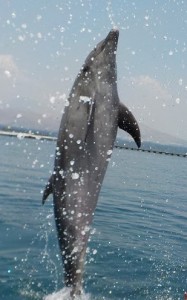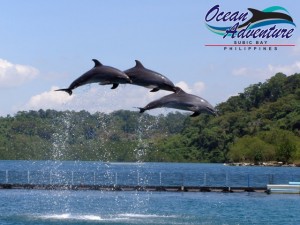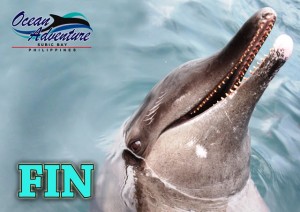Another March, another birthday, and finding I had no great inclination to party, we headed north to Subic instead, where rumour had it there were dolphins to be met. It’s a three-hour drive from Makati – about 120 km north-west of the CBD – so we decided not to rush, but went for the weekend, and spent a lazy afternoon lounging by the pool, wandering along the seafront and, of course, eating.
The website for ‘It’s More Fun in the Philippines’ says Subic is a ‘sublime’ place to visit, full of ancient rainforests, restaurants and boats. It also clearly says ‘Don’t confuse [Subic Bay Freeport Zone] with Subic [town]… although an equally exciting trip, the town [Subic} is about 10 kilometers from the area.’ Unfortunately, I didn’t read that page before I booked our hotel, and thanks to this pathetic lack of research, we found ourselves on the far side of the bay from the Freeport Zone and even further removed from Ocean Adventure, where we were due to swim with the dolphins on Sunday morning. And it was quite a long drive: Subic Bay is a much bigger area than we had realized.
With its deep harbour, Subic Bay was used by the Spanish as a port. After the Spanish-American war of 1898, ownership was transferred to the United States, who held it from 1899-1991 (apart from three years of Japanese occupation in WWII), and created America’s largest naval base outside the United States, giving America a firm footing in SE Asia. Today it belongs once again to the Philippines and Subic Bay has been transformed into an industrial centre and a duty-free commercial precinct. Yet signs of its former incarnation remain: the coastline is dotted with abandoned barracks, while the bay is dotted with shipwrecks from both the Spanish-American war and World War II, which attract many divers.
I just came for the dolphins.
Before our date with the dolphins, though, we had time to watch the Wild World show, where we were introduced to a fascinating selection of Indigenous birds, reptiles and mammals: a beautiful but top-heavy horn bill; a sleek and scaly python; a large but rather shy fruit bat who kept flitting off-stage. (Later that day we would pass a whole colony of fruit bats in the wild, swarming like bees on two or three huge trees at the side of the road. I haven’t seen them in such numbers since we lived in Sydney.)
As we waited for the next exhibit, a shadow passed over our heads. On a thick vine that stretched across the audience
from the front to the rear of the auditorium, a bear cat paced like a tight-rope walker, using its tail to help it balance. The bear cat is the emblem of our sons’ school, so I have seen cartoon images reproduced on t-shirts and sports kit and posters. But I had never seen a live bear cat. We were quite entranced. He looked, quite literally, as he sounds: a blend of bear and cat, heavy-set and ponderous with a long fluffy, prehensile tail, sharp teeth and thick, bear-like fur. And he certainly didn’t look as fierce as the logo. (Although bear cats can be found all across Asia, loss of habitat and hunting have severely depleted their numbers.)
When the show finished, we wandered across the park to prepare for our session with the dolphins. On Filipino time, we pottered through a promotional video as staff fitted us with life jackets and warned us to remove any accessories that might scratch the dolphins. (It is hardly surprising that dolphins are renowned for their friendliness when their wide mouths seem permanently stretched into a broad smile, and it is hard not to respond with delight. Yet I fear that it is a misconception to assume happiness where there seems to be a smiling face.)
Eventually we headed to the beach, where two dolphins were waiting for us in the shallows. Summer had suddenly struck, and Subic was steaming, so we had no reservations at all about stepping into the sea, well doused in sun screen and hoping we would survive sunstroke without our hats. In two groups of five, we were escorted down into the water to cluster around one dolphin each. There, our guide introduced us in great detail to our new friend, Nahla, whose name means “first drink of water” in Arabic and “gift” in Swahili.
Nahla is a bottle-nosed dolphin, but unusually, this nose is not for breathing. Instead, she breathes through the blow-hole on back of her head. This is also how she speaks, using signature whistles to communicate, and a clicking sound as an echolocation device. (Echolocation is a means of receiving information by sending out sound waves and then gauging the proximity of other objects from the responding echoes.)
Nahla was happy to show off her ability to hold her breath underwater (for up to seven minutes, we were told), and blow water at us out of the air hole when she re-surfaced. I am always a little anxious in zoos and wildlife parks about how animals respond to captivity and doing tricks, but while obviously a little bored with our interest and enthusiasm, it seems that Nahla at least is a born show-off, and happy to go through her paces for pieces of fish that her trainer kept secreted in a bum bag around her waist. Initially we stroked her smooth, satin skin carefully, but very quickly we had all relaxed, and were posing happily for hugs and kisses.
Information varies on the effects of captivity. One website I read assured me that, if properly cared for, dolphins can live up to twenty-five years in captivity – about twice the time they will survive in the wild. But others made my heart sink as they talked of unnatural behavior and the detrimental effects of captivity on such a free-spirited animal. And yet, for some of the rescue dolphins at Ocean Adventure, who have lost their hearing as a result of dynamite fishing, survival in the wild would have been impossible. (This violent method of fishing is also causing irreparable damage to Philippine reefs.)
In the meantime, despite my anxieties, it was an utter joy to have the opportunity to come so close to this beautiful, gentle and fun-loving mammal. We all examined Nahla’s physical attributes – from her almost human teeth and tongue to her strong tail, or fluke, which she uses to propel herself through the water at speeds of up to 20km an hour. We could feel the force of which that tail is capable when she used it to carry each of us across the bay, first on her back with her “rider” holding her flippers like hands; then back again, when we rode on her back, clutching her dorsal fin and attempting to keep our legs out of the way of the strong thrusts of her tail, apparently oblivious to the weight of two less-than-petite Australians.
 And then there were the balletic, mid-air leaps and spins. Apparently in the wild this is a movement with multiple purposes: to orient themselves and see what or who is around; as a social display; in fighting, or just for fun. It is even used as a method of dislodging parasites. They can also spin on their tails in the water – as we observed first hand when Nahla invited us to dance with her, and, wrapping our legs around her body, we were spun about in dizzyingly tight circles. And I am reminded of that pithy conversation at the beginning of Gallipoli, the movie:
And then there were the balletic, mid-air leaps and spins. Apparently in the wild this is a movement with multiple purposes: to orient themselves and see what or who is around; as a social display; in fighting, or just for fun. It is even used as a method of dislodging parasites. They can also spin on their tails in the water – as we observed first hand when Nahla invited us to dance with her, and, wrapping our legs around her body, we were spun about in dizzyingly tight circles. And I am reminded of that pithy conversation at the beginning of Gallipoli, the movie:
Jack: What are your legs?
Archy: Springs. Steel springs.
Jack: What are they going to do?
Archy: Hurl me down the track.
Nahla, too, hurled herself around the pool, as if she had steel springs in her tail.
We were also able to observe the dolphins speeding through the water without human cargo, and they set a cracking pace. Later we would watch the trainers water-skiing across the pool, somehow balanced on the dolphins’ backs, looking for all the world like Dash in The Incredibles, as their turbo-charged steeds whipped through the water.
All in all, this opportunity to interact with Nahla and her friends was an amazing experience. And putting a positive slant on it, it has given us a far greater appreciation and understanding of the dolphin, and made us all more aware of the need to preserve these beautiful creatures, as they struggle to survive the dangers of a sea dominated and damaged by human mismanagement and interference. I hope so, but I wonder…


